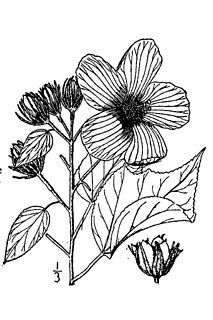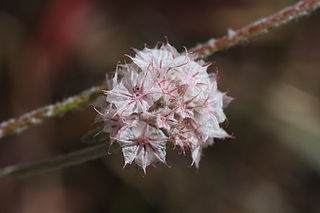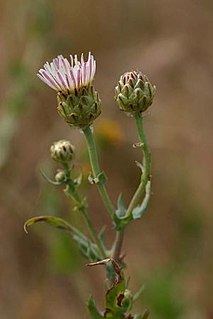
Bougainvillea glabra, the lesser bougainvillea or paperflower, is the most common species of bougainvillea used for bonsai. The epithet 'glabra' comes from Latin and means "bald".
Eryngium castrense is a species of flowering plant in the family Apiaceae known by the common name Great Valley eryngo, or Great Valley button celery. This plant is endemic to California, where it grows in wet areas such as vernal pools and ponds in the central part of the state. This is a heavily branched, spiny perennial herb reaching maximum heights of around half a meter. It produces light green to grayish green hairless stems with occasional lobed, oval-shaped leaves. At the tops of the stems are flower heads one to one and a half centimeters wide and rounded or egg-shaped. At the base of each head is an array of 7 to 9 spiny, pointed bracts up to three centimeters long, and sometimes a few smaller bractlets above. The rounded flower head contains many small white to light purple flowers.

Hibiscus lasiocarpos is a species of hibiscus known by the common name hairy-fruited hibiscus. It is also one of several hibiscus called rosemallow. It is native to much of the southeastern United States, as well as parts of California and northern Mexico. It is a large, bushy perennial herb with sprawling stems reaching one to two meters long. The leaves are heart-shaped, toothed, and pointed, and generally between 6 and 10 centimeters long. The inflorescence holds large showy, solitary flowers. Each flower has a cup of partly fused sepals beneath a layer of slender bracts. These may be covered in hairs or woolly fibers. The flower's large petals may be up to 10 centimeters long and are generally bright white with red bases. The stamen tube and anthers are white or cream. The fruit is a capsule 2.5–3 centimeters long containing spherical seeds.
Chorizanthe diffusa is a species of flowering plant in the buckwheat family known by the common name diffuse spineflower. It is endemic to California, where it grows on the coastline and mountains of the Central Coast, in sandy scrub, woodland, and forest habitat. It is erect to prostrate in form, its stem generally no longer than 15 or 20 centimeters. The leaves are up to 2 centimeters long and mainly arranged about the base of the plant. The inflorescence is a cluster of flowers, each surrounded by six hook-tipped bracts. The margins of the bracts proximal to the long hooked tip may be very thin and nearly invisible to wide and obvious, and they may be green to white to purplish. The flower itself is about 3 millimeters wide and white with a yellow throat. The tips of its tepals may be smooth or jagged or toothed.

Chorizanthe douglasii is a species of flowering plant in the buckwheat family known by the common names San Benito spineflower and Douglas' spineflower. It is endemic to California, where it grows in the mountains of the Southern California Coast Ranges, from the Santa Lucia Range east to the Gabilan Range.

Chorizanthe membranacea is a species of flowering plant in the buckwheat family known by the common name pink spineflower. It is native to Oregon and California, where it is widespread and in some areas quite common. It can be found in a wide variety of habitats.

Malacothrix coulteri is a species of flowering plant in the aster family known by the common name snake's head, or snake's head desertdandelion. It is native to the southwestern United States is also found in southern South America where it is an introduced species. Its native habitat includes desert, grassland, chaparral, and other open, sandy areas. It is an annual herb producing a waxy, upright flowering stem up to about 50 centimeters in maximum height. The leaves, which are mostly located near the base of the stem, are toothed or not. The inflorescence is an array of flower heads with nearly spherical involucres of scale-like phyllaries one to two centimeters wide. The bracts are green, often with dark striping or marking. The yellow or white ray florets are about a centimeter long.

Mirabilis nyctaginea is a species of flowering plant in the four o'clock family known by several common names, including wild four o'clock, heartleaf four o'clock, and heartleaf umbrella wort.
Monardella breweri is a species of flowering plant in the mint family known by the common name Brewer's monardella.
Monardella macrantha is a species of flowering plant in the mint family known by the common name red monardella. It is native to coastal mountain ranges of southern California and Baja California, where it grows in several habitat types, including chaparral, woodlands, and forest.
Monardella palmeri is a species of flowering plant in the mint family known by the common name Palmer's monardella.

Navarretia breweri is a species of flowering plant in the phlox family known by the common name Brewer's navarretia. It is native to much of the western United States, where it grows in open habitat types.
Nemacladus ramosissimus is a species of flowering plant in the bellflower family known by the common name smallflower threadplant. It is native to the mountains and deserts of the southern half of California and adjacent parts of Baja California. It is a small annual herb producing a thread-thin erect brown or purplish stem up to about 32 centimeters tall. Lobed oval leaves under 2 centimeters long occur at the base of the plant. The inflorescence is a series of branches bearing occasional flowers on thin, curving pedicels. There is a single small bract at the base of each pedicel. The flower is no more than 2 millimeters long with five white lobes fused along the lower half.

Orthocarpus cuspidatus is a species of flowering plant in the broomrape family known by the common names Copeland's owl's clover, Siskiyou Mountains orthocarpus, and toothed owl's-clover. It is native to mountain and plateau habitat in Oregon, California, and Nevada. It is an annual herb producing a slender, glandular, hairy, purple-green stem up to about 40 centimeters tall. The narrow leaves are up to 5 centimeters long, the upper ones deeply divided into three linear lobes. The inflorescence is a dense cylindrical spike of wide, oval green bracts with pinkish points. The flowers emerge from between the bracts. Each purple-pink flower is fuzzy in texture and club-shaped, the lower lip an expanded pouch and the upper lip a narrow, straight beak.

Orthocarpus imbricatus is a species of flowering plant in the broomrape family known by the common name mountain owl's-clover. It is native to western North America from British Columbia to northern California, where it grows in meadows and other mountain habitat.
Orthocarpus pachystachyus is a rare species of flowering plant in the broomrape family known by the common names Shasta owl's-clover and Shasta orthocarpus. It is endemic to central Siskiyou County, California, where it is so rarely seen it was thought to be extinct until 1996, when eight individuals were located. The plant grows in an isolated wilderness but since it apparently only occurs on one single hillside it is considered very vulnerable to extinction.
Psilocarphus elatior is a species of flowering plant in the aster family known by the common names tall woollyheads, meadow woollyheads and tall woolly-marbles. It is native to the Pacific Northwest in western North America from Vancouver Island, where it is known from just a few occurrences, to northern California. It grows in seasonally moist spots such as meadows, spring seeps, and vernal pools.
Silene aperta is a rare species of flowering plant in the family Caryophyllaceae known by the common names naked catchfly and Tulare campion. It is endemic to Tulare County, California, where it is known only from the coniferous forests of the High Sierra Nevada. It is a perennial herb growing from a woody, branching caudex sending up several erect stems up to about 60 centimeters tall. The lower leaves are linear in shape, up to 12 centimeters long but less than one wide. Leaves higher on the stem are smaller. The flower has a hairy, tubular calyx of fused sepals with ten veins. The calyx is open at the top, revealing five white or yellow-green petals each 1 to 2 centimeters long.

Leucospermum glabrum is an evergreen, rounded, upright shrub of up to 2½ m (8 ft) high, that is assigned to the family Proteaceae. It has broad inverted egg-shaped leaves with seven to fourteen teeth near their tips, and oval flower heads of about 8 cm (3.2 in) in diameter, with hairy, orange and carmine-coloured flowers from which long styles with a thickened end emerge, giving the flowerhead as a whole the appearance of a pincushion. It flowers between August and October. Its common name is Outeniqua pincushion in English and Outeniekwa-kreupelhout in Afrikaans. It naturally occurs in a limited area on the south coast of South Africa.

Acanthoscyphus is a monotypic genus in the family Polygonaceae that contains the single species Acanthoscyphus parishii, which is sometimes called Parish's oxytheca. This species is native and endemic to southern California.











